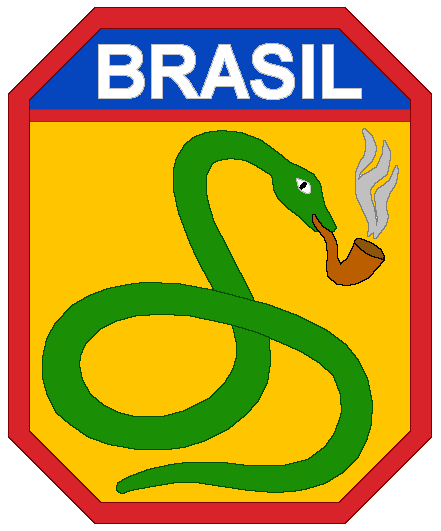 |
| War memorial donated to Montese by the FEB |
The FEB in Italy
 The F.E.B. adopted a particular coat of arms depicting a cobra smoking a pipe.
The F.E.B. adopted a particular coat of arms depicting a cobra smoking a pipe.
The reference is to a speech made by Vargas in which the president said: “It was easier for a snake to smoke than Brazil ever enter the war”. However, the “snake did smoke” with destination Italy.
The Brazilian infantry, under the command of General Joào Baptista Mascarenhas de Moraes, arrived in Italy by sea in the summer of 1944 spaced out in 5 intervals they then joined ranks with the IV Corps of the Fifth U.S. Army.
The war front in the Appennines
In early November, after first confrontations with the Germans in Garfagnana, the Brazilians were transferred to the Reno Valley, where they found an entirely, unknown enemy awaiting them: the Apennine winter. With headquarters in Pistoia, the F.E.B. took part in all the operations destined to break through the front around the ss 64 Porrettana highway. Despite heavy losses and the cold season, The Brazilians managed to obtain important tactical position information from the Germans. The journey from Mount Castello, Castelnuovo, Montese and Zocca which led them to Fornovo, Alessandria and Torino, cost the division 474 dead and 2,738 wounded by the end of April, 1945.
The F.E.B. in the Reno Valley
In the early days of November,1944 the FEB was transferred from Garfagnana to the war front in the Reno Valley flanking the Americans. During the winter the south American troops found extreme cold conditions, snow and humidity along the Apennines, constant enemy attacks were trying to undermine the physical and psychological resistance of the Brazilian troops not accustomed to low temperatures and already under pressure from more than three months of fighting at the front. Between November 24 and December 12, 1944, Brazilian soldiers participated in the unsuccessful attacks on Mount Castello, one of the strongholds of the German defense. All attempts failed as well as the attempts to free Mount Belvedere: Brazilians and Americans left behind many casualties. Only after the arrival of the American 10th Mountain division, trained and equipped for war in the mountains did this situation end.
The front of Mount Belvedere
While the Allies failed to make a breach in the Gothic Line, at the end of September 1944 the Germans were stationed on the ridges that ran from Mount Belvedere, in the north-east to the left of the Reno River, controlling the area around the ss Porrettana 64 highway, the main road towards Bologna and northern Italy. The front remained stationary for six long months during which the Apennines between the Reno and Panaro were ravaged by war with tragic suffering for the civilian population.








